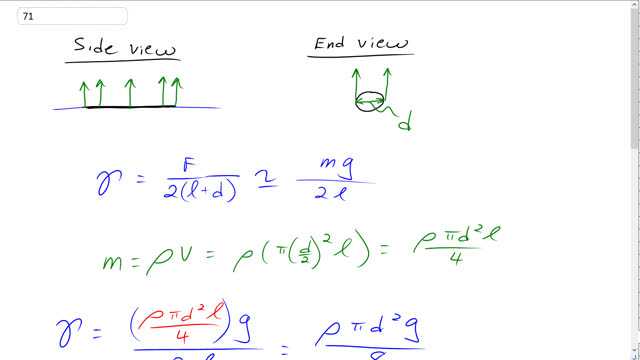
Estimate the diameter of a steel needle that can just barely remain on top of water due to surface tension.

In order to watch this solution you need to have a subscription.
This is Giancoli Answers with Mr. Dychko. Here's a side-view of the needle; the needle is this black line that's resting atop of the blue water and there's all these force arrows pointing upwards due to the surface tension and the end-view looks like this where you have this needle making a depression in the water and to the point where the surface tension is... surface tension is always acting parallel to the surface of the water and so in this case, the needle has pushed the water down so far to its maximum point such that the surface tension is acting straight up. And the surface tension is being exerted on both sides of the needle and so for calculating gamma, surface tension is gonna be force divided by 2 times this total length of the needle plus the two diameter ends but approximately, this is just gonna be mg over 2l; the force exerted on the cross-sectional ends of the needle can be negligible compared to its long length. So mg over 2l is gonna be γ. Now we have to find mass and it's gonna be the density of steel times volume and this needle is cylindrical so the volume is gonna be the area of one end times the length so that's π diameter over 2 squared times length which is gonna be density times πd squaredl over 4— I have diameter in there because it asks us for the diameter. So we substitute that in for mass so γ is ρπd squaredl over 4 times g over 2l and thankfully the l's cancel because we don't know what the l is so that's a good thing that that canceled and so we have ρπd squaredg over 8 in the end. And we can solve this for d squared first and multiply both sides by 8 and divide by ρπg and then take the square root of both sides and you get that the diameter is square root of 8γ divided by ρπg and this is the maximum diameter because of the assumption that the surface tension force is straight up otherwise it'd have to be some cos Θ business in there to find the component of the tension force that's upwards but in this case, we are at the maximum possible and so that surface tension force is straight up. So that's square root of 8 times the surface tension of water at 20 degrees— 0.072 newtons per meter— and then divide by density of steel— 7.8 times 10 to the positive 3 kilograms per cubic meter— and then times π times 9.8 newtons per kilogram and that's about 1.5 millimeters is the maximum diameter of this steel needle that will still float on the water due to surface tension.